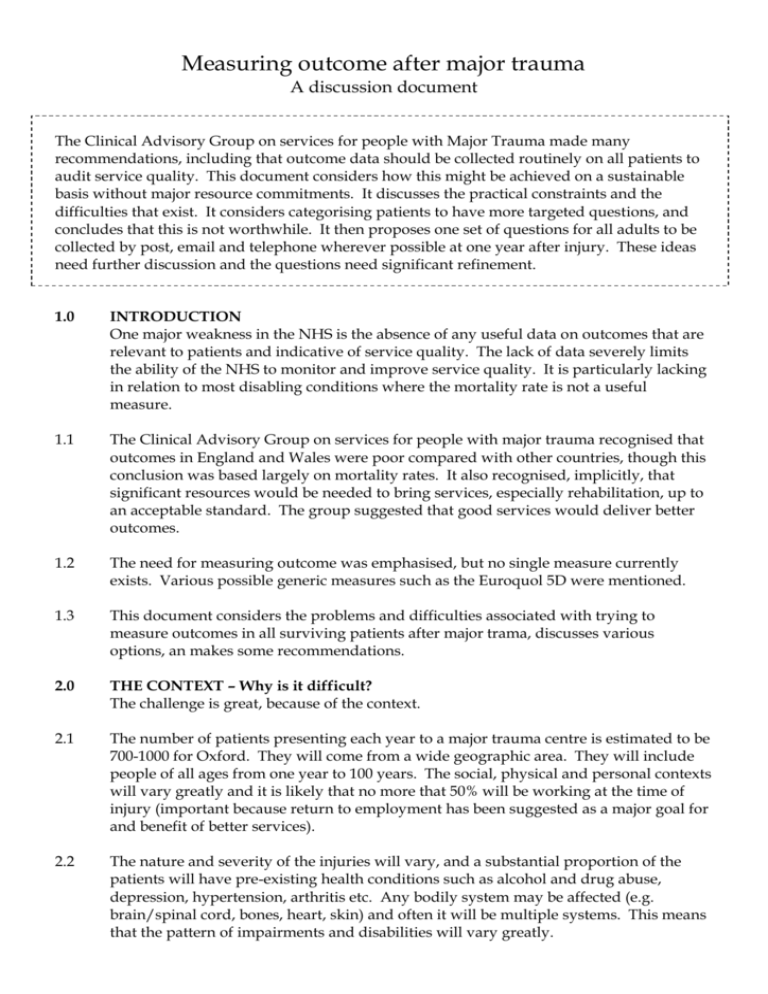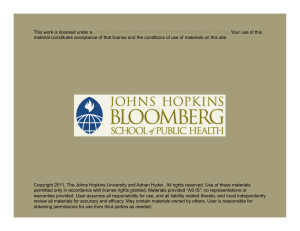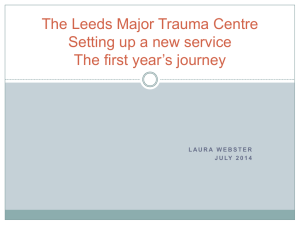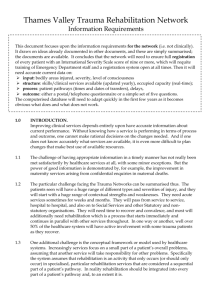Measuring outcome after major trauma
advertisement

Measuring outcome after major trauma A discussion document The Clinical Advisory Group on services for people with Major Trauma made many recommendations, including that outcome data should be collected routinely on all patients to audit service quality. This document considers how this might be achieved on a sustainable basis without major resource commitments. It discusses the practical constraints and the difficulties that exist. It considers categorising patients to have more targeted questions, and concludes that this is not worthwhile. It then proposes one set of questions for all adults to be collected by post, email and telephone wherever possible at one year after injury. These ideas need further discussion and the questions need significant refinement. 1.0 INTRODUCTION One major weakness in the NHS is the absence of any useful data on outcomes that are relevant to patients and indicative of service quality. The lack of data severely limits the ability of the NHS to monitor and improve service quality. It is particularly lacking in relation to most disabling conditions where the mortality rate is not a useful measure. 1.1 The Clinical Advisory Group on services for people with major trauma recognised that outcomes in England and Wales were poor compared with other countries, though this conclusion was based largely on mortality rates. It also recognised, implicitly, that significant resources would be needed to bring services, especially rehabilitation, up to an acceptable standard. The group suggested that good services would deliver better outcomes. 1.2 The need for measuring outcome was emphasised, but no single measure currently exists. Various possible generic measures such as the Euroquol 5D were mentioned. 1.3 This document considers the problems and difficulties associated with trying to measure outcomes in all surviving patients after major trama, discusses various options, an makes some recommendations. 2.0 THE CONTEXT – Why is it difficult? The challenge is great, because of the context. 2.1 The number of patients presenting each year to a major trauma centre is estimated to be 700-1000 for Oxford. They will come from a wide geographic area. They will include people of all ages from one year to 100 years. The social, physical and personal contexts will vary greatly and it is likely that no more that 50% will be working at the time of injury (important because return to employment has been suggested as a major goal for and benefit of better services). 2.2 The nature and severity of the injuries will vary, and a substantial proportion of the patients will have pre-existing health conditions such as alcohol and drug abuse, depression, hypertension, arthritis etc. Any bodily system may be affected (e.g. brain/spinal cord, bones, heart, skin) and often it will be multiple systems. This means that the pattern of impairments and disabilities will vary greatly. Outcome after major trauma – measurement. Page 2 2.3 Measuring severity in terms of the prognosis for functional outcomes (rather than mortality) is not yet possible. Moreover the imprecision associated with defining ‘severe’ will add difficulties when comparing groups (over time or between centres). Thus it is not possible to target assessment according to initial severity. 2.4 The outcomes also vary greatly from long-term unawareness (permanent vegetative state) through a range of outcomes requiring residential or institutional care onto a range of survival in the community with no roles on to more-or-less complete recovery possibly with no residual problems. This means that the measurement tool(s) used must cover a very wide range. 2.5 Outcome should probably be measured 12 months after the trauma because this will capture the effects of rehabilitation and will usually be after the majority of complex restorative direct treatments are complete. This makes is difficult to track patients and makes face-to-face contact expensive and impractical. 2.6 Lastly the goal should be to have some data on every surviving patient, which means that the method of collecting data must be robust, and the questions simple. 2.7 These features impose many restrictions. 2.8 First it is improbable that any set of questions would be equally appropriate across all patients. Consequently it may be important to categorise patients into easily defined groups. However, as will become apparent, this may in fact not be worthwhile. 2.9 Second, face-to-face data collection would be totally impractical. The resource implications would be large, and many patients would not attend. A combination of methods such as emails and web-based data collection, telephone interviews and postal data collection will be needed. 2.10 Third, the set of data will need to be limited if data are to be collected from as many people as possible. Questionnaires that take longer than 15 minutes to complete are unlikely to be completed fully by all people. 2.11 Last the questions themselves will need to be simple and unambiguous, easily translated, and easily read to people who cannot read. 3.0 CATEGORISATION OF PATIENTS The question arises as to whether or not patients should be categorised. The advantage is that the limited number of questions available could be more targeted, leading to better discrimination. If used, categorisation would have to be made simple and only dependent upon a small set of data available at the time of first admission. The following categories could be considered. 3.1 Age It would seem appropriate to divide patients by age, because children will have different expected outcomes socially. This would be done by age at time of accident. Between two and four groups could be considered. Outcome after major trauma – measurement. Page 3 3.2 The first group would be aged 0-5 years, chosen because this group is often not at school, and will be fully dependent upon adults. 3.3 The next group would be aged 6-16 years, because they are all at school. 3.4 The major issue is whether or not to leave all adults in a single group aged 17+ years, or whether to separate out people likely to be working or to be active socially and in other ways and those more likely to have concomitant illness and less likely to have been working. 3.5 Thus one might have a group aged between 17 and 70, and a fourth group aged 71 years or more, or one might simply take all patients aged 17 years and more. 3.6 Organs damaged The types of problems and outcomes to be expected may differ between neurological and non-neurological injuries. Further sub-classification within the non-neurological injuries is unlikely to be helpful. 3.7 Thus one might have two groups: patients with any significant/document damage to the brain or spinal cord are placed into one group, even if they have extensive and possibly greater injuries in other systems; and the remaining patients who would form the second group. 3.8 Other items Other items could be considered, such as initial injury severity. The prognostic value of severity in predicting outcome or likely impairments is too low to be useful. Information on severity (International Severity Score; ISS) may be used to interpret findings but should not determine measures used. 3.9 Discussion and conclusion In practice questions relating to disability will generally be similar in all groups, and these questions are of most relevance. Symptoms may differ between different groups, but if one restricts questions of symptoms to common distressing symptoms then again a common set tend to emerge. 3.10 Thus I would recommend that simplicity is more important than discrimination, and that the only categorisation to be considered should be between adults and children. 4.0 QUESTIONS – GENERAL PRINCIPLES The following principles should increase the accuracy and completeness of data collected. 4.1 The questions should be short, specific and should relate to personal activities (what some actually does) or personal experiences. This is relevant to patients, increasing completion rates, and it is also concordant with the general philosophy of Patient Related/Reported Outcome Measures (PROMs). 4.2 The answers available need to be equally unambiguous and clear. Outcome after major trauma – measurement. Page 4 4.3 The whole data-set (i.e. all the questions as a whole) needs to cover a range of key activities from the basic to the complex, and needs to cover personal experiences and perceptions such as pain. It also needs, as far as possible, to relate to or gain information about the situation immediately before the trauma. 4.4 Once the data-set is agreed, it will be vital to give serious attention to the design of any forms, questionnaires, web-pages etc to ensue that they are as clear and easy to complete as possible. 5.0 DOMAINS TO COVER The data-set will need to cover the following domains of interest both in children and adults. 5.1 Activities This needs to cover: personal care: probably dressing and toilet use mobility: probably walking around house and walking around a supermarket dexterity: using a knife and fork (together or separately) domestic activities: preparing a simple snack Community activities: using a bus, visiting a shop vocational activities: paid work, voluntary work educational activities: attending similar school or college, or not leisure activities: one as before accident social interaction: hold a conversation with two other people Experiences We should ask about experience of: pain visual problems auditory problems fatigue embarrassment emotional state concentration sleep Social context We should cover: contact with family members contact with friends Physical context: We should ask about: Housing in comparison to before need for equipment 5.2 5.3 5.4 5.5 Overall Outcome after major trauma – measurement. Page 5 extent of change quality of life or satisfaction with life 6.0 CONCLUSIONS and RECOMMENDATIONS The primary conclusion that I draw, which was not what I initially thought, is that a single set of data items should be used for all adults whatever their age and injuries. 6.1 The data items should focus on activities as these are of most relevance to patients, and as they are important in all patient groups. 6.3 A proposed set of data items is attached as a second document. The following should be noted. 6.4 It includes one long-established standard questionnaire, the life satisfaction questionnaire. Otherwise it comprises a set of single items. There are developing data banks of items, and it may be possible to select questions from these. Dr Derick Wade, Consultant and Professor in Neurological Rehabilitation, Director of Trauma Rehabilitation in Thames Valley (Bucks Berks, Oxon) Oxford Centre for Enablement, Windmill Road, Oxford OX3 7HE Tel: 01865-737306; Fax: 01865-737309; email: derick.wade@ouh.nhs.uk derick.wade@ntlworld.com January 29th 2012










